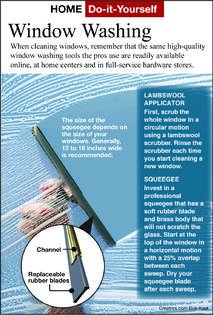Here's How: Professional Window Cleaning Tips
Professional Window Cleaning Tips
Dear James: My new house has many windows and I have a problem cleaning them without leaving streaks, especially on the south-facing ones. How do professionals clean them? -- Alex J.
Dear Alex: You probably had streak-free windows when you moved in. This is because the builder likely hired a professional window cleaner. They have both the proper cleaning tools and techniques to eliminate streaks as the windows dry. With the sun on southern window, streaks are more apparent.
During the first year after construction, it is important to keep the window glass clean with the proper cleaning techniques. Dust from cement, shingle granules, cutting tool blades, etc., will be present for quite a while after the house is completed. All of these materials are very abrasive, and they can damage the glass surface and some can react chemically with it.
If you have ever watched a professional washer, you probably did not see him using a spray bottle and a roll of paper towels. This technique removes some of the abrasive dirt, but much of it is just spread in an even film over the glass. It may look fine at night, but when the sun hits it, it is a mess.
To really clean windows well, you must remove all the dirt and then rinse it thoroughly before you attempt to dry it off. A good quality squeegee and a lambswool-type scrubber are a must for a good job. A medium- to long-nap fleece scrubber is also effective for applying the soapy solution.
The key is to get the scrubber well saturated with the solution so that it both picks up the majority of the dirt from the glass as it floods and rinses it. When it is squeegeed dry, only clean solution is being squeegeed off. Remember that glass is relatively soft and porous, so rubbing it hard with dirty paper towels can scratch and dull its surface over time.
If some of the glass windows still have some specks of cement, paint or tree sap on them, try using a "porcupine" scrubber. This type of scrubber has strong synthetic bristles with coarse ends. It will not scratch the glass, but it will dislodge the heavier dirt. A scraper will also help, but always use a new blade that has no burrs that may cause fine scratches on the glass.
Using the squeegee properly to remove the water is the final and most important step. Make sure to use a high-quality, professional squeegee with a brass body and replaceable rubber blades. Brass is a relatively soft metal, so it will not scratch the glass if you bump it. An 18-inch wide one works best, but you might try a 12-inch squeegee first to get the hang of it.
If you have trouble finding a professional squeegee, try janitorial supply outlets in your area. You might also contact the following companies for local dealers or to order directly: Ettore Products Co., Haviland Corp., and Unger.
The proper squeegee technique is a horizontal pass across the window starting at the top. Tilt the squeegee so that the water flows down on to the already wet area below. After each stroke, wipe off the squeegee with a lint-free cloth (most paint stores sell these). Overlap each stroke by about 2 inches for the best results.
When you are done with the squeegee, use the lint-free cloth in a vertical direction down each edge of the glass to remove all the water. Another good tip is to never clean windows in the sun. The heat from the sun will cause the window to dry too quickly to avoid streaks.
========
Send your questions to Here's How, 6906 Royalgreen Dr., Cincinnati, Ohio, 45244 or visit www.dulley.com. To find out more about James Dulley and read features by other Creators Syndicate writers and cartoonists, visit the Creators Syndicate website at www.creators.com.
Copyright 2024 Creators Syndicate Inc.






























Comments